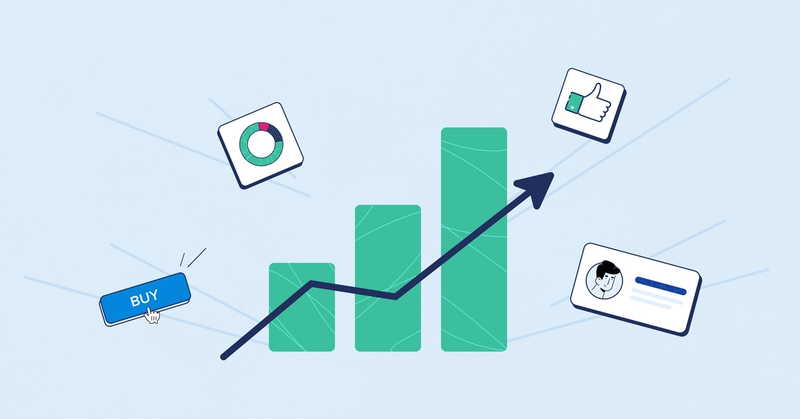What is a conversion rate?
A conversion rate is the percentage of people who take a desired action. The action could be to sign up to your software, webinar or proposal.
Conversion rate = Number of those taking desired action / Total number * 100
If you are trying to find the conversion rate for people signing up to your software online the calculation would be:
Conversion rate = Number of signups / Total visitors * 100
If you have 2,000 signups a month and 6,000 visitors your conversion rate is 33%ß
Why is conversion rate useful?
It’s a strong metric to assess the effectiveness of your marketing and sales tactics. If, for example, you’re running PPC ads, your conversion rate will show you how well the ad is performing. If you only have a 1% conversion rate, it’s worth looking at your ad content again and improving your message, call to action or offer.
If you have a sales process in place with many stages, it’s useful to calculate the conversion rate between each step. You can spot where people drop out, uncover the reasons why and put steps in place to improve it.
Calculating your overall conversion rate from the first point of contact to a won deal helps you forecast more accurately. It also helps the marketing and sales team focus on the amount of interest they need to generate to hit their sales objectives.
A conversion rate also helps you manage your team more effectively as you can see who and what activities result in more sales. Once you know this you can share best practice across the team.
Now we know what a conversion rate is and why it's useful - how do you improve it?
1. Understand your audience and their buying behavior
It’s crucial to understand your audience, everything from their pain points to the time it takes to make a buying decision. Once you know exactly who you’re trying to attract and how to entice them, you can target them more effectively through a clear proposition alongside targeted marketing and sales activities.
When you know their buying behavior and their decision making process, you can craft a more accurate sales pipeline to track your opportunities and your conversion rate.
2. Dive deep into your sales data
If you have a CRM in place, this should be quick to do. If you’re using spreadsheets, it’s time to do some formulas!
You’re looking to get a good understanding of your current conversion rate and what activities or people have the greatest success. It’s important to see what currently happens at each stage of your sales process and how this differs by salesperson. You'll also be able to see how well the team's activities reflect the insights you’ve uncovered earlier on.
An example is finding out the decision-maker in your industry is the Head of Sales, but in your current process, you've been communicating with the Marketing team. This could be one of the reasons why you lose opportunities at a specific stage. Pro-actively engaging with the Head of Sales throughout the sales process, will increase your conversion rate.
3. Define your sales process
Once you understand your audience and their decision-making process, together with your team, you can define a solid sales process. It’s likely your sales team has already settled into a familiar way of working but if this isn’t effective it’s worth getting together to test a new way, that plays to their skill sets.
4. Focus on the relationship, not the sale
Understanding how your salespeople sell is also a good way to uncover potential areas of improvement if your conversion rates are lower than expected. Shadowing them as well as talking to them about their tactics is incredibly useful.
It certainly helps improve conversion rates when a salesperson builds a good relationship with the customer from day one. There are many different ways of doing this depending on your industry. If you have a high-value customer and product, for example, starting with a discovery meeting or consultation puts the focus on the customer’s needs, instead of the sale. The meeting helps the salesperson truly understand the challenges and more able to qualify the opportunity as genuine.
If you sell directly to customers online, a consultation or discovery call may not be cost-effective so it’s important to have all the information you know a potential customer needs easily accessible on your website. FAQs are useful along with the clear benefits and testimonials from businesses relevant to their industry. Genuine proof your product solves their problems always helps to improve conversion rates.
5. Ask the right questions early on
Conversion rates can be affected by many things such as poor sales qualification processes. You may get 1000s of leads into the business, but not everyone is a potential sale. If you don’t distinguish between the two early on, you run the risk of focusing the sales efforts in the wrong places and creating a lot of noise in your sales data.
For face to face sales, asking the right questions when you first engage with the person interested in purchasing your product or service, will help you understand the potential opportunity straight away. Examples include:
- What budget is available?
- What are the decision criteria for this purchase?
- Who are the key decision-makers?
- What timings are they working to?
- Is this solution a priority for the business?
- What are their expectations for the next steps?
- Are they reviewing other solutions?
If the budget is not yet signed off and the key decision-makers are not yet involved, this could be a non-starter or a slow burner. Experience will tell you how these opportunities play out and you can make a call on whether to include them in your sales data.
6. Regular, relevant communications
Once you’re confident the opportunity is real it’s time to nurture the sale through your process. How you do this is dependent on your business model but we do know that regular, relevant communications have a positive impact. Whether this is an onboarding email automation program or more personal communications on a one-to-one level.
However, there’s a fine line to staying in touch and being a pest so it’s important to tread carefully.
As a busy salesperson, it can become quite difficult to stay on top of every opportunity without a bit of help from technology. This is when a CRM becomes a critical tool as it will keep you organized and in control of your sales pipeline. You’ll easily find all the important notes and details from prior interactions on your device, saving your time and memory.
Most CRM systems, like Capsule, will also notify you when it’s time to get in touch with the person you spoke to last week or the week before - they’re like you’re very own Personal Assistant. Spreadsheets and calendars, on the other hand, can be very difficult to synchronize.
Another incredibly useful feature of a CRM system is the ability to help standardize a process when you’ve figured out a winning formula. In Capsule, for example, you can create a list of linked tasks that a salesperson can add to every new opportunity. This list can guide them on the qualification questions and follow-up activity, so everyone is following best practices.
7. Measure your progress regularly
When looking at improving conversion rates, you’ll have lots of ideas you’ll want to implement straight away. But where you’re unsure of the impact, it’s worth doing some AB tests. Testing your new activity on 50% of your opportunities for a set time period will help you see if it’s having a positive effect.
When you’re improving your sales processes and activities, be sure to measure your conversion rates regularly. Again a CRM system will make this a lot easier for you to do as it's done automatically.
Other useful features to help accurately calculate your conversion rate include the prompt to record the reason for a lost opportunity. This is critical information to help you understand what’s going wrong at each stage.
Sometimes an opportunity is dropped for reasons outside of a salesperson’s control such as huge organizational change or a key driver in the decision-making process leaving the business. Certain CRMs, like Capsule, will let you omit this lost sale from your overall conversion rates, ensuring the figure you have is only based on the activities under your sales person’s control.
Understanding your conversion rate and identifying positive steps to improve it will have a positive impact on your sales and the overall team performance. If you're looking for a CRM system to help you track and improve your conversion rate, try Capsule for free for 14 days.

![Automate contact creation in Capsule from LinkedIn leads [With Magical]](https://cdn.sanity.io/images/poftgen7/production/142b6351ab8fc46e6af8f2a3fd4155042daf24eb-1200x628.png?w=300&h=157&q=75&fit=max&auto=format)


